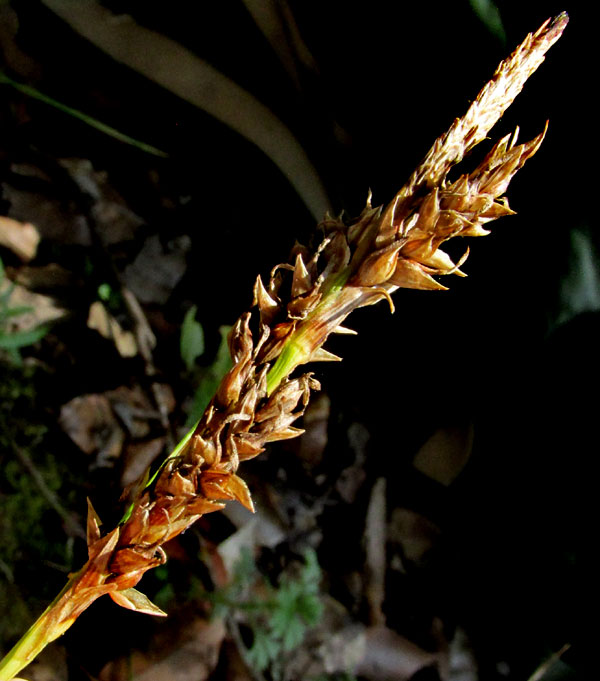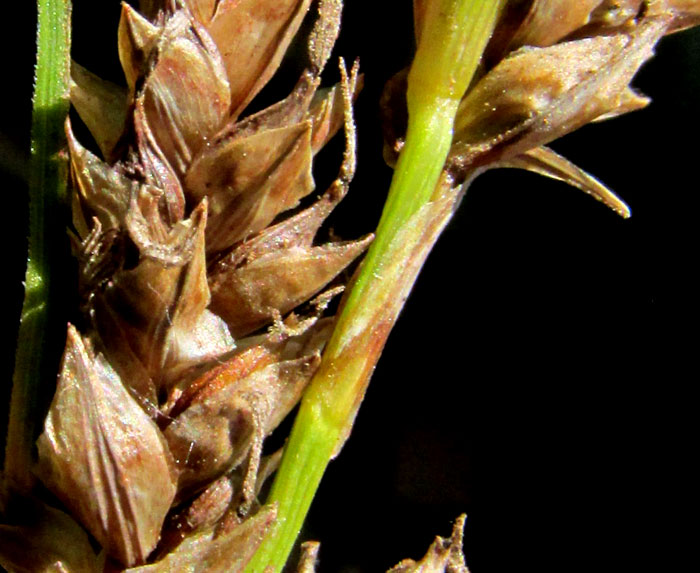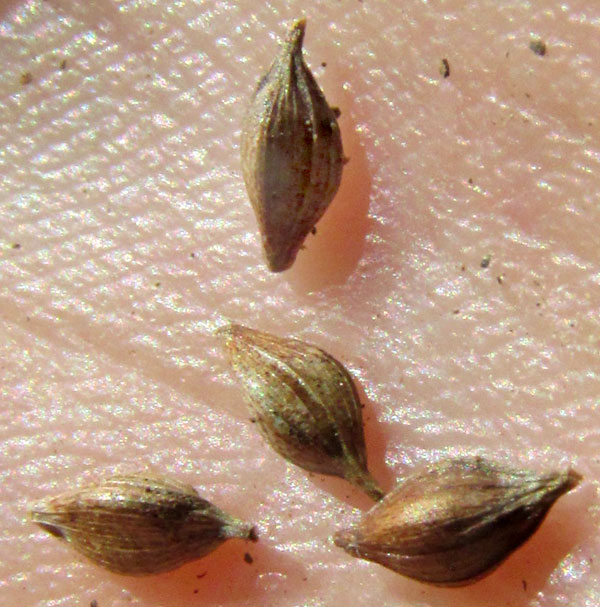Excerpts from Jim Conrad's
Naturalist Newsletter
entry from field notes dated July 2, 2022, taken on Cerro de la Cruz, at an elevation of ~2885m (~9465 ft), just south of the community of El Pinar, Amealco de Bonfil, Querétaro, MÉXICO, (~N20.17°, ~W100.17°)
CARIBBEAN SEDGE
 At the mouth of a valley opening toward the east and mantled with oak forest, the sedge whose inflorescences are shown at the right grew in rich soil deeply covered with oak leaves, in the bed of a seldom-flowing arroyo.
At the mouth of a valley opening toward the east and mantled with oak forest, the sedge whose inflorescences are shown at the right grew in rich soil deeply covered with oak leaves, in the bed of a seldom-flowing arroyo.
Most people don't know that sedges, genus Caryx, exist. With around 2000 species, though, they form a huge and important group of plants, almost worldwide in distribution, mostly found in moist to wet habitats, and often in mountains. Many forms of wildlife graze on their herbage, and eat the small, achene-type fruits.
In Mexico, over 140 species have been documented. There's no treatment of Caryx for our area, but in Veracruz state to our east, the Flora de Veracruz covers 27 species. The thing about sedge identification is that you have to pay attention to details.
Above we see that our sedge's flowers are clustered atop the stem. Important to notice is that at the plant's very tip, in the picture's top, right corner, there' a spike of unisexual male flowers. Below that spike, the thicker spikes, which earlier bore just female flowers, now bear almost mature fruits. Below the peduncles arise fairly long, slender, leafy bracts.

Up closer we have a better idea of things, but even a closer look is needed to see the fruits' main features:

In the above picture, each achene-type fruit is somewhat egg-shaped, at the top tapering to a pointed "beak." Atop the beaks arise slender styles with stigmatic surfaces, where pollen germinates. Each achene is subtended and largely enveloped by a broad, sharply pointed, strongly ribbed scale about as long as the achene. On this species the styles are jointed atop the beak, and at maturity fall off, though on many species there's no joint.

The above achenes, somewhat three-cornered, display numerous longitudinal ribs. Having found that two lines of friction ridges on the palm of my hand are 1mm wide, the achenes can be estimated to be about 4 mm long, 4.5 if you count the beak.
In the Flora of Veracruz our sedge "keys out" to a cluster of species defined by what I consider vague and undependable features: the species standleyana, humboldtiana, polystachya, pertunuis and perlonga. Only one of those, polystachya, is commonly encountered and well documented in our area, while I can't find mention of the others as occurring in Querétaro. Therefore, despite being unable to compare our plant's features with those shown in close-up pictures or drawings of this species -- features one must be sure about for any solid sedge identification -- I'm filing this page under the name CAREX POLYSTACHYA.
Carex polystachya sometimes is called the Caribbean Sedge, because it occurs in the Caribbean, as well as most of Mexico, and south through Central America into South America, in habitats from sea level to mountainous forests of oaks and pines. Occupying such a vast distribution area and appearing at such a range of elevations, it's to be expected that there's considerable geographical variation in the plant's appearance, and maybe there are various look-alike species traditionally lumped together as Carex polystachya.
The authoritative Flora of North America assesses the current understanding of Carex classification by saying that "Although the classification and phylogeny of Carex have been the subjects of much debate, the evidence does not allow definitive conclusions." Also, "Recent investigations of the genus and related genera utilizing DNA sequences have both clarified and confused the classification and phylogeny of the genus."
Those remarks apply to the much studied species of North America. You can imagine the taxonomic uncertainty surrounding our Mexican sedges.
Whatever the case, at least this page will help future researchers know that what's shown in our pictures, whether it's Carex polystachya or not, can appear in rich soil at the bottom of an oak-forest-covered valley at about ~2885m (~9465 ft) in elevation, in southern Querétaro state, México.